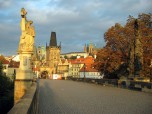The Dancing House is an unusually designed building in Prague. It is officially known as the Nationale-Nederlanden building, but this name is seldom used. The house is the creation of the architects Vlado Milunić and Frank Gehry, and lies on the city’s riverfront. Its striking design caused considerable debate when it was built in the 1990’s, but the building has now become sufficiently accepted to be depicted on one of the Czech National Bank’s gold coins.
Background and History
The house stands on what was formerly a vacant lot, created by the American bombing of Prague late in World War Two. The resulting ruins were cleared in 1960, but it was not until the 1980’s that serious plans began to be discussed for a building to occupy the space. The dissident Václav Havel, who would become the country’s president after the 1989 Velvet Revolution, was among those who heard of the plans. Once elected, Havel suggested that the site could be used for a cultural center, an idea which did not succeed.
Nationale-Nederlanden, the Dutch precursor to the present ING Bank, committed itself to sponsorship of a building on the plot in 1991, selecting Milunić to lead the project. The bank asked Milunić to work with another architect of global renown, Jean Nouvel, but he declined the offer as he felt the space allowed was too small. Gehry, however, did agree to become involved and he quickly formed a solid working partnership with Milunić after meeting in 1992.
The bank was, at the time, one of the most stable and respected companies in the banking sector, and was in excellent shape financially. This meant that it could, and did, commit to spending almost without limitation on the new project. From the time of that first Geneva meeting onward, the two architects dreamed up a dramatic design that would contain two contrasting elements. These were intended to reflect the country’s switch to democracy from communist dictatorship, although during the building’s construction, Czechoslovakia had split into the Czech Republic and Slovakia.
Architectural Details
The building’s unusual style, which the designers sometimes called neo-baroque, consisted of 99 differently-shaped panels of concrete, topped by Medusa, a twisted metal sculpture. The overall impression was that of two dancers whirling around each other, something that led Gehry to give the house the nickname of “Fred and Ginger”, after Astaire and Rogers, the legendary Hollywood dance pair. However, he later changed his mind, saying that he was unhappy with the idea of bringing “American kitsch” to a city such as Prague, and few people now use that nickname.
The location of the Dancing House, in a heavily built-up part of the Czech capital, has caused some controversy. The building is very different in appearance from the vast majority of its neighbors, which tend to employ art nouveau or traditional baroque architecture. Between the time of construction beginning in 1992 and the building’s completion four years later, this debate was at its height. However, in recent years most inhabitants of Prague have accepted the structure as an integral part of their city.























